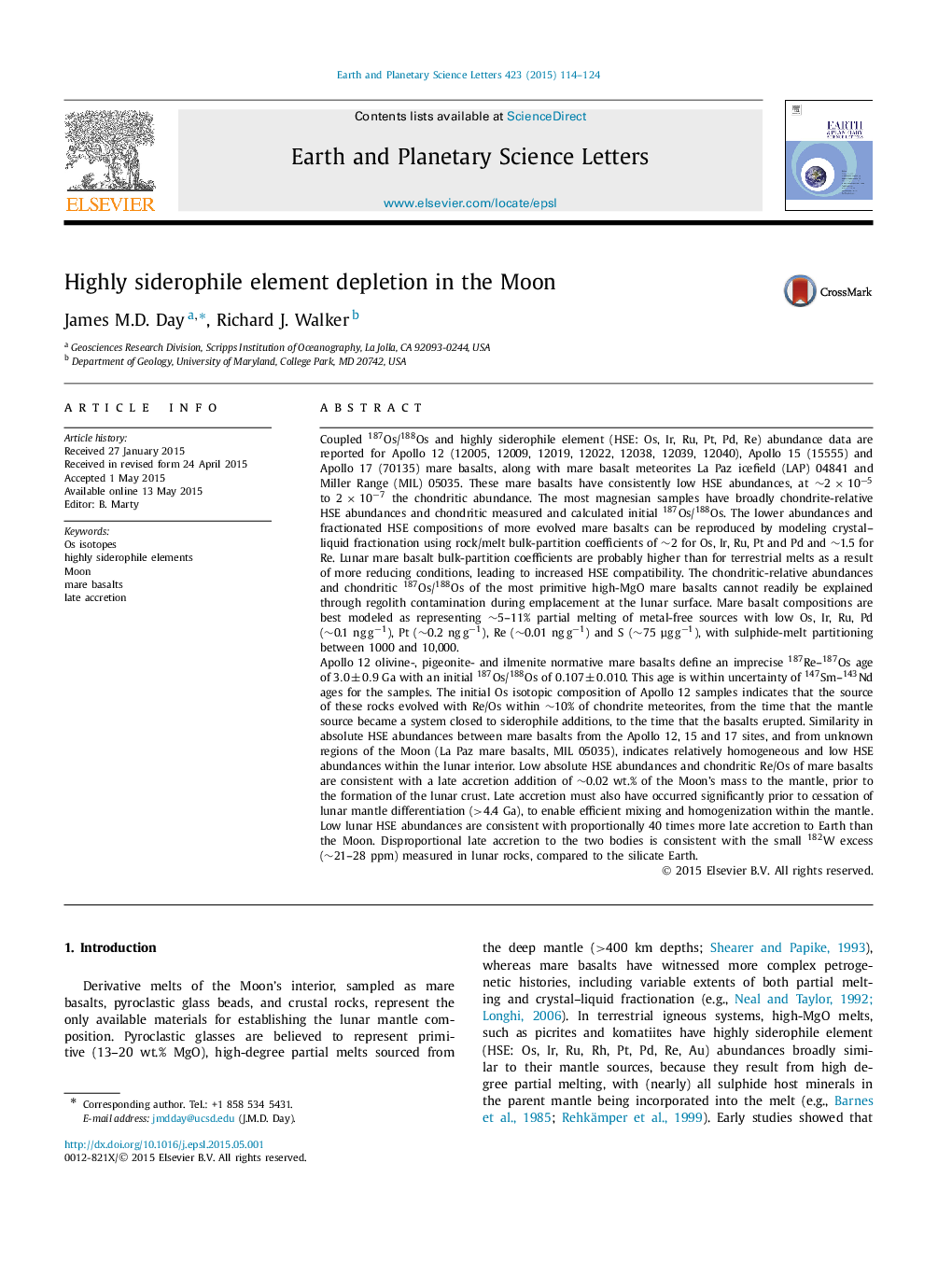| کد مقاله | کد نشریه | سال انتشار | مقاله انگلیسی | نسخه تمام متن |
|---|---|---|---|---|
| 4676972 | 1634733 | 2015 | 11 صفحه PDF | دانلود رایگان |
• The HSE appear to be homogeneously distributed within mare basalt source regions.
• Mare basalts HSE abundances consistent with ∼5–11% partial melting of mantle sources.
• Apollo 12 mare basalts yield 187Os/188Os of 0.107±0.0100.107±0.010 at ∼3.2 Ga.
• ∼0.02% late accretion addition is required prior to completion of lunar differentiation (>4.4 Ga).
Coupled 187Os/188Os and highly siderophile element (HSE: Os, Ir, Ru, Pt, Pd, Re) abundance data are reported for Apollo 12 (12005, 12009, 12019, 12022, 12038, 12039, 12040), Apollo 15 (15555) and Apollo 17 (70135) mare basalts, along with mare basalt meteorites La Paz icefield (LAP) 04841 and Miller Range (MIL) 05035. These mare basalts have consistently low HSE abundances, at ∼2×10−5∼2×10−5 to 2×10−72×10−7 the chondritic abundance. The most magnesian samples have broadly chondrite-relative HSE abundances and chondritic measured and calculated initial 187Os/188Os. The lower abundances and fractionated HSE compositions of more evolved mare basalts can be reproduced by modeling crystal–liquid fractionation using rock/melt bulk-partition coefficients of ∼2 for Os, Ir, Ru, Pt and Pd and ∼1.5 for Re. Lunar mare basalt bulk-partition coefficients are probably higher than for terrestrial melts as a result of more reducing conditions, leading to increased HSE compatibility. The chondritic-relative abundances and chondritic 187Os/188Os of the most primitive high-MgO mare basalts cannot readily be explained through regolith contamination during emplacement at the lunar surface. Mare basalt compositions are best modeled as representing ∼5–11% partial melting of metal-free sources with low Os, Ir, Ru, Pd (∼0.1 ng g−1), Pt (∼0.2 ng g−1), Re (∼0.01 ng g−1) and S (∼75 μg g−1), with sulphide-melt partitioning between 1000 and 10,000.Apollo 12 olivine-, pigeonite- and ilmenite normative mare basalts define an imprecise 187Re–187Os age of 3.0±0.9 Ga3.0±0.9 Ga with an initial 187Os/188Os of 0.107±0.0100.107±0.010. This age is within uncertainty of 147Sm–143Nd ages for the samples. The initial Os isotopic composition of Apollo 12 samples indicates that the source of these rocks evolved with Re/Os within ∼10% of chondrite meteorites, from the time that the mantle source became a system closed to siderophile additions, to the time that the basalts erupted. Similarity in absolute HSE abundances between mare basalts from the Apollo 12, 15 and 17 sites, and from unknown regions of the Moon (La Paz mare basalts, MIL 05035), indicates relatively homogeneous and low HSE abundances within the lunar interior. Low absolute HSE abundances and chondritic Re/Os of mare basalts are consistent with a late accretion addition of ∼0.02 wt.% of the Moon's mass to the mantle, prior to the formation of the lunar crust. Late accretion must also have occurred significantly prior to cessation of lunar mantle differentiation (>4.4 Ga), to enable efficient mixing and homogenization within the mantle. Low lunar HSE abundances are consistent with proportionally 40 times more late accretion to Earth than the Moon. Disproportional late accretion to the two bodies is consistent with the small 182W excess (∼21–28 ppm) measured in lunar rocks, compared to the silicate Earth.
Journal: Earth and Planetary Science Letters - Volume 423, 1 August 2015, Pages 114–124
